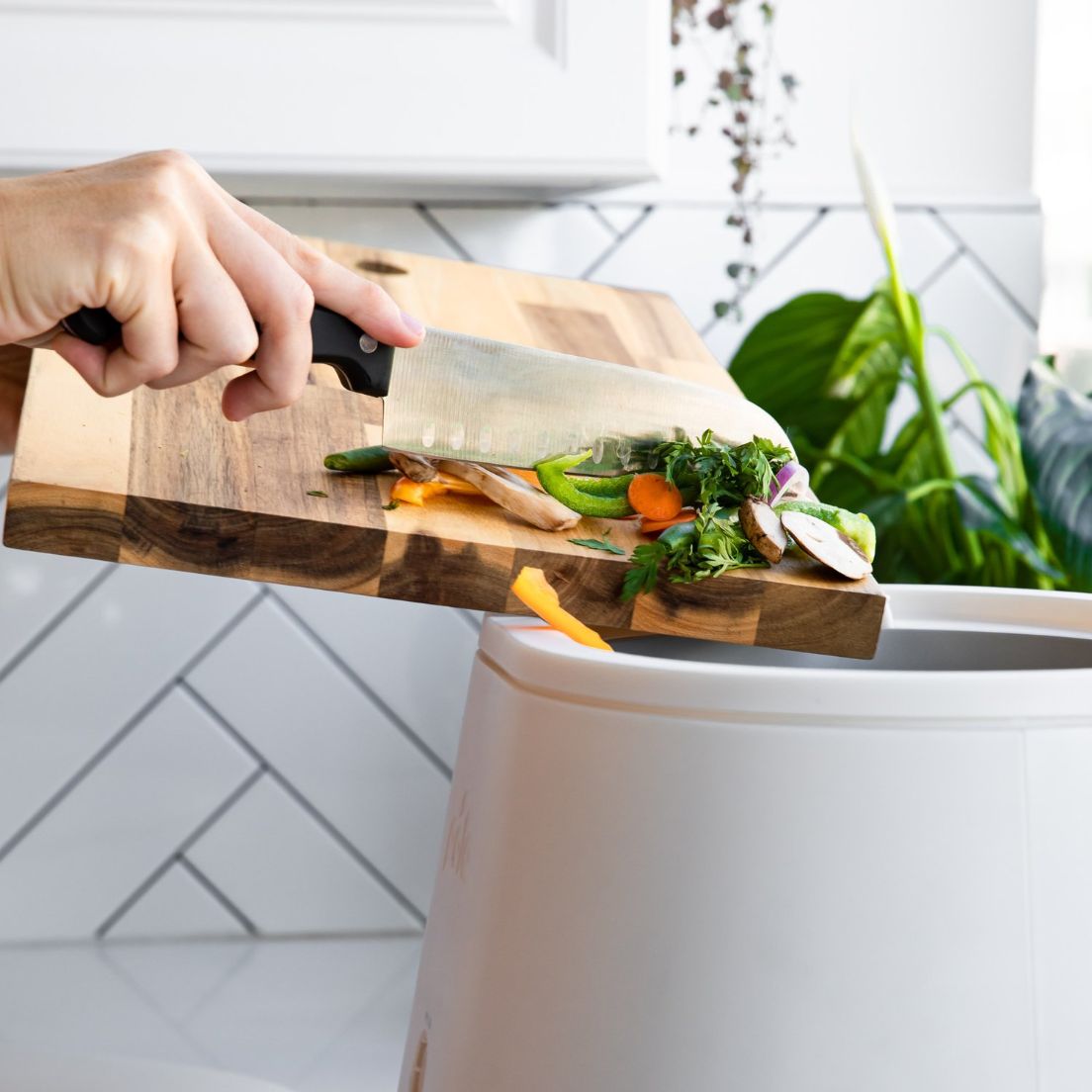
Composting food waste saves landfill space, reduces methane production, and gives you fertilizer for your garden – but it also attracts bugs if you're not careful. Unfortunately, composting and gardening have their icky side, which often shows up in the form of flies and maggots in the compost. Here's what to do to get rid of them and prevent new ones from appearing.
High on the list of people who want to do something with food waste other than throwing it out is composting. Backyard composters and kitchen compost bins have made that easy for many, but these bins also sometimes invite unwelcome creatures in the form of flies and maggots. No one likes seeing these, and if they're in your home, they can be a real nuisance (and an absolute gross-out at mealtimes).
Keep two things in mind if you start seeing bugs: One, you can get rid of the bugs, and two, you can prevent them to some extent. They are really common, so you're not alone. But that offers little comfort when you're being dive-bombed in your kitchen by flies after your dinner.
Should There Be Any Bugs in a Compost Bin?

Flies actually play a role in getting food waste into compost. When flies and maggots crawl around the compost material, they aerate it, and they help the decomposition process along by leaving their droppings in the compost. So, if you see one fly, that's not much of a problem. (In general, it's not; it's not so good if the fly starts exploring your kitchen.)
But it's not good to see infestations. If you open the compost bin and find several flies and maggots, that indicates something is wrong with how you're composting. And those flies can spread, attacking food you leave out, including that meal you just made. No one wants flies in their face.
The Different Types of Flies You Might Find in a Compost Bin

"Flies" is a really general term. You may see different types of compost bin flies, and getting rid of them partly depends on knowing what you're dealing with. Four main types are prevalent.
Vinegar Flies and Fruit Flies

Fruit flies and vinegar flies are similar; they differ mainly in what they feed on. Fruit flies are small, brownish, and have reddish eyes. They like overripe and rotting fruit, and if you've ever left a bunch of bananas on the counter for a few days, you've likely seen fruit flies appear. They are annoying, but they can be controlled.
Vinegar flies are similar to fruit flies but prefer the yeasts that inhabit rotting fruits. Of course, that isn't going to make much of a difference to your eyes. Both fruit and vinegar flies can fly into your face, land on your food, and generally be a nuisance. Vinegar fly larvae can help compost decomposition, but that still doesn't mean you want to have families of them picnicking in your home.
If you have a problem with fruit or vinegar flies, you need to get rid of the flies, the source, and potential spots where there might be larvae.
For the adult flies, you can buy commercial fruit fly traps or create one yourself using apple cider vinegar and dish soap in a jar with a funnel or paper cone that lets the flies drop in. They then drown in the concoction (the soap is necessary to break the surface tension on the vinegar).
Should that not work, because sometimes it doesn't, you can also take – and this is for real – a vacuum with the floor attachment removed and wait for a fly to land. Suck up the fly through the hose, and repeat until you don't see any more adult flies. You might have to repeat this over a couple of days.
Change the bag afterward, too, if your vacuum cleaner uses bags; empty the canister and clean it if there are no bags. You don't want the flies breeding inside your vacuum.
For sources, take out garbage immediately. Take the garbage out daily for the next several days, even if there isn't much in the bin.
All food sitting out, including fruit in a fruit bowl, should be tossed as it may have eggs; food you buy to replace the food you toss needs to go in the refrigerator, even tomatoes and potatoes (fruit flies love these).
Put grease-fighting dish soap in your sink drain (such as Dawn) and then run the hot water if anything is trying to set up a home in the sink drain. Don't use boiling water as that can affect plastic pipes; just use hot water from the tap.
House Flies

House flies are the flies you picture when someone mentions "flies": the buzzy, black bugs that like to hang around garbage. They are gross, to put it lightly, and if they're in your compost pile, you need to act fast. Take out the garbage, remove food that was left out, and set up fly traps for flies that are buzzing around outside the bin.
Soldier Flies

Soldier flies can be helpful, believe it or not, but they look scary, and you don't want lots of them. They look almost like a cross between a black house fly and a wasp, so they can be a shock to see in your home.
Their maggots help break down food waste into compost – you can actually buy soldier fly larvae for compost bins – but they can quickly turn into pests if they overwhelm the bin.
How Do You Get Rid of Flies and Maggots in Compost Bins?

So you know now how to clean up outside the bin to get rid of flies that came in from the outside or that were on your produce. But what if the bugs were attracted to the compost itself and are living in it?
From the flies ' point of view, these flies tend to be attracted to the green waste in the bin, those kitchen scraps, and fresh yard trimmings that are nice and juicy. Adding more brown waste is one way to cut down on the food available to the flies. It's dry, not nutritious for them, and they can't feed off it.
Normally you need to keep a good mix of the two in the bins, generally between "2:1 green to brown" and 50-50 for both; it's possible you put too much green waste in at one point.
At this point, you really want to emphasize brown waste and stop adding green waste for a while. It will slow decomposition, but getting rid of the flies and maggots needs to be a priority now. Try to top off new green-waste additions to the bin with more brown material, too, once the fly problem has been solved.
Stirring the compost to aerate it may help by raising the pH a bit. Remember to top off the compost with brown waste when you're done.
Some sources recommend adding lime to change the pH of the compost to make it inhospitable for flies and maggots. Other sources do not recommend lime as the lime can create ammonia gas and increase the odor of the compost.
Adding baking soda is also controversial. You may want to stick with brown waste and aeration for now.
Why Do Fruit Flies Love Compost? And Why Do They Have to Go After Mine?

Fruit flies and other flies go after all compost; don't take an infestation personally. If you ended up with an infestation, it just means there was some access to suitable food at the end of the journey. Now you know you need to re-evaluate how you're composting.
Are Fruit Flies a Huge Problem?
Fruit flies in compost can be a huge problem because they are prolific breeders, and you can carry their eggs in on products you buy without realizing it. They can also fly in from outdoors. Nearly everyone has a problem with them at one point or another.
Ways You Can Prevent Fruit Flies in That Kitchen Composter

Preventing fruit flies (and vinegar flies, etc.) from overwhelming the kitchen countertop compost bin is not that hard.
1. Keep the Lid on It
Those little countertop bins, like Lomi, come with lids, and you actually need to use them. Don't leave the bin open as you gradually fill the bin with waste. Close it securely after each addition. That cuts off access to the food waste.

Check out our article on 16 best indoor compost bins to select the one that's right for you!
2. Bury Everything
After adding any green waste, cover it with brown waste. Don't let any green waste remain exposed to the air, even if the lid is closed most of the time.
3. Keep Mixing Brown and Green Waste

When you mix brown and green waste together, you speed up the decomposition of the brown waste (as there's less of it clumped together) and help protect the green waste from flies (as the brown waste helps dry the green waste out a bit). Keep mixing those, both as you add the waste and during the decomposition process, through stirring.
4. Try a Cover Material
As already mentioned, simply adding some brown waste as a sort of cover whenever you add green waste can also stop flies from getting to the compost. Yes, some larvae can be beneficial, but covering the green waste will help stop too many larvae from forming.
5. Some Materials Need to Be Composted Outside

Meats, dairy products, and fatty products should be composted outside in a compost heap. As these decompose, they can really smell and attract a lot of flies, especially house flies. If you've been trying to compost them inside, that could be part of the reason why you have so many flies around.
6. Try a Banana Peel Trap

Similar to the apple cider vinegar/dish soap fruit fly trap is the banana peel trap, and you can keep this near the compost bin if you start to see fruit flies around. Place some of that vinegar along with banana peels in a cup or jar, place plastic wrap with holes in it across the top, and see how many fruit flies fall for it.
7. Wrap the Whole Thing Up
Something you might want to try is wrapping the green waste in brown waste such as newspaper or compostable butcher paper. That wrapping prevents flies from getting into the green waste when it's fresh.
8. Freeze the Compost!
If your problem is that you're saving up food scraps to compost in one batch, and the flies are attacking that pile, then you need to change your storage method. Anything you're saving up to compost (that you're not depositing straight into the bin once you're done with the food) should go into a bag that you store in your freezer. That will prevent odors and stop bugs from accessing the waste.
Conclusion
If flies in compost tumbler bins are a problem for you, no worries. You can take steps to eliminate the flies and prevent them from appearing in the next batch of compost. Countertop units like Lomi let you help break down food waste securely, with a speedy decomposition time and a lid that helps protect the waste from bugs that can quickly turn into a problem.
